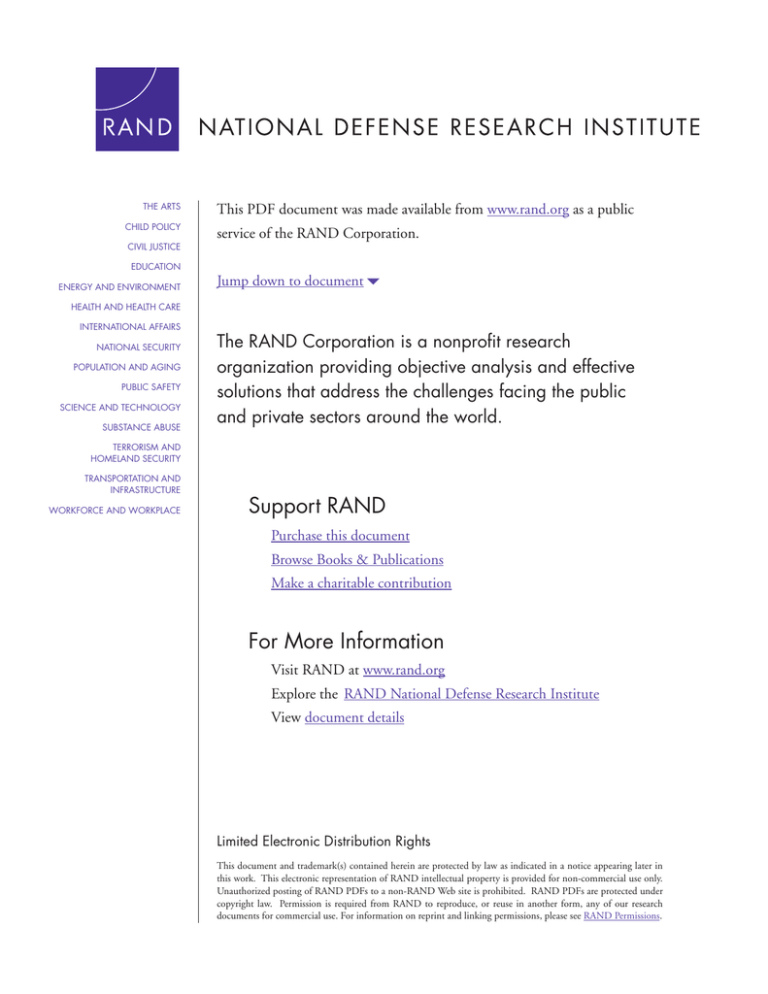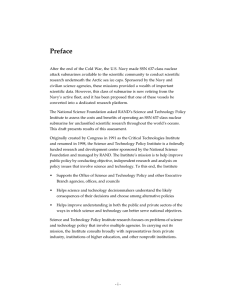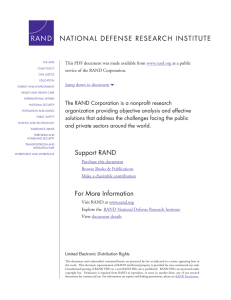
THE ARTS
CHILD POLICY
CIVIL JUSTICE
EDUCATION
ENERGY AND ENVIRONMENT
This PDF document was made available from www.rand.org as a public
service of the RAND Corporation.
Jump down to document6
HEALTH AND HEALTH CARE
INTERNATIONAL AFFAIRS
NATIONAL SECURITY
POPULATION AND AGING
PUBLIC SAFETY
SCIENCE AND TECHNOLOGY
SUBSTANCE ABUSE
The RAND Corporation is a nonprofit research
organization providing objective analysis and effective
solutions that address the challenges facing the public
and private sectors around the world.
TERRORISM AND
HOMELAND SECURITY
TRANSPORTATION AND
INFRASTRUCTURE
WORKFORCE AND WORKPLACE
Support RAND
Purchase this document
Browse Books & Publications
Make a charitable contribution
For More Information
Visit RAND at www.rand.org
Explore the RAND National Defense Research Institute
View document details
Limited Electronic Distribution Rights
This document and trademark(s) contained herein are protected by law as indicated in a notice appearing later in
this work. This electronic representation of RAND intellectual property is provided for non-commercial use only.
Unauthorized posting of RAND PDFs to a non-RAND Web site is prohibited. RAND PDFs are protected under
copyright law. Permission is required from RAND to reproduce, or reuse in another form, any of our research
documents for commercial use. For information on reprint and linking permissions, please see RAND Permissions.
This product is part of the RAND Corporation technical report series. Reports may
include research findings on a specific topic that is limited in scope; present discussions of the methodology employed in research; provide literature reviews, survey
instruments, modeling exercises, guidelines for practitioners and research professionals, and supporting documentation; or deliver preliminary findings. All RAND
reports undergo rigorous peer review to ensure that they meet high standards for research quality and objectivity.
Using the Steel-Vessel
Material-Cost Index to
Mitigate Shipbuilder Risk
Edward G. Keating, Robert Murphy,
John F. Schank, John Birkler
Prepared for the United States Navy
Approved for public release; distribution unlimited
NATIONAL DEFENSE RESEARCH INSTITUTE
The research described in this report was prepared for the United States Navy. The research
was conducted in the RAND National Defense Research Institute, a federally funded
research and development center sponsored by the Office of the Secretary of Defense, the
Joint Staff, the Unified Combatant Commands, the Department of the Navy, the Marine
Corps, the defense agencies, and the defense Intelligence Community under Contract
W74V8H-06-C-0002.
Library of Congress Cataloging-in-Publication Data is available for this publication.
ISBN 978-0-08330-4229-3
The RAND Corporation is a nonprofit research organization providing objective analysis
and effective solutions that address the challenges facing the public and private sectors
around the world. RAND’s publications do not necessarily reflect the opinions of its research
clients and sponsors.
R® is a registered trademark.
© Copyright 2008 RAND Corporation
All rights reserved. No part of this book may be reproduced in any form by any electronic or
mechanical means (including photocopying, recording, or information storage and retrieval)
without permission in writing from RAND.
Published 2008 by the RAND Corporation
1776 Main Street, P.O. Box 2138, Santa Monica, CA 90407-2138
1200 South Hayes Street, Arlington, VA 22202-5050
4570 Fifth Avenue, Suite 600, Pittsburgh, PA 15213-2665
RAND URL: http://www.rand.org
To order RAND documents or to obtain additional information, contact
Distribution Services: Telephone: (310) 451-7002;
Fax: (310) 451-6915; Email: order@rand.org
Summary
The U.S. Navy wants to provide its shipbuilders with appropriate incentive to produce militarily effective vessels at minimum cost to the Navy.
The Navy can induce a shipbuilder to agree to any contractual arrangement by offering
the shipbuilder a high enough price. But it is likely to be preferable, at least ex ante, for the
Navy to dissipate risk external to its shipbuilder to pay less for the systems the Navy needs.
The Navy uses external labor- and material-cost indexes to attempt to correct for significant
cost risks outside its shipbuilders’ control. Shipbuilder profits are greater when actual cost
growth is less than the indexes’ cost growth and conversely.
A longtime material-cost index in Navy shipbuilding is the steel-vessel index. It is a
weighted average of three Bureau of Labor Statistics (BLS) producer price indexes (45 percent
iron and steel, 40 percent general-purpose machinery and equipment, and 15 percent electrical
machinery and equipment).
One criticism of the steel-vessel index is that it does not accurately cover the materials
used in building a modern ship. No modern U.S. Navy ship, for instance, has 45 percent of its
material costs in iron and steel. To combat this shortcoming, the DDG-51 and T-AKE programs created their own material-cost indexes with lower weighting on iron and steel.
Historically, BLS’s iron and steel price index has been much more volatile than has the
general-purpose machinery index, the electrical machinery index, or economywide inflation.
Consequently, the steel-vessel index has been more volatile than have material-cost indexes
with lower weights on iron and steel.
The known mismatch between the steel-vessel index’s composition and a shipbuilder’s
actual material cost structure is problematic. The shipbuilder bears a risk that the prices of iron
and steel may tumble while the shipbuilder’s costs do not. A risk-averse shipbuilder will require
a premium to bear this cost structure–mismatch-driven risk.
We urge the Navy to develop a modern-vessel index that more appropriately represents the material used in constructing ships. The more accurately a material-cost index captures a shipbuilder’s external material cost risk, the less we expect the Navy to have to pay its
shipbuilders.
ix







